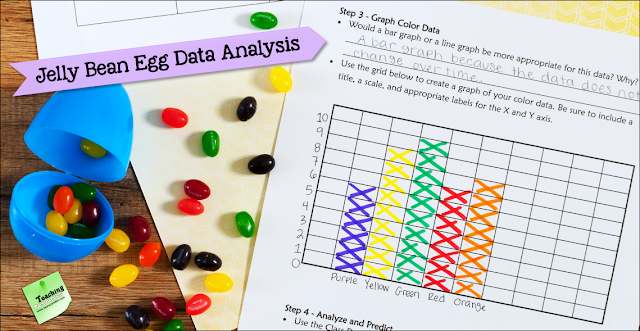For example, the Jelly Bean Egg Challenge is a sweet statistics lesson that requires students to measure, estimate, collect, compile, and graph jelly bean data in order to analyze it and draw conclusions. Give each student a plastic egg filled with an assortment of jelly beans, and let the fun (and learning) begin!
The basic activity directions, printables, and a class data chart are included in my April Activities for Upper Elementary pack. Here are 5 more ways to dig even deeper into that lesson.
- Explore Fractions, Decimals, and Percents
After having your students sort and count jelly beans by color, ask them to represent the number of each color as a fractional part of the total. If appropriate, have them convert those fractions to decimals and percents. - Introduce Graphing Concepts
Use the jelly bean color data to introduce basic graphing concepts and have students create their own graphs on blank graph paper or a blank grid. Discuss questions like these: Which type of graph would be best for this type of data, a line graph or a bar graph? Why? What increment size should be used? What labels should go on the horizontal and vertical axes? - Create Spreadsheet Graphs
Demonstrate how to enter individual jelly bean color data into a spreadsheet and choose the appropriate type of graph from the given options. - Measure and Compile Data
Have kids measure the circumference of the plastic eggs and weigh them before removing the jelly beans. Create a class data chart showing the egg weights and numbers of jelly beans inside each one. Estimate and predict the number of jelly beans inside a sealed egg based on its weight. Predict the number of jelly beans in a sealed egg based on it's weight. - Analyze Class Data
After the class data is compiled, have students determine the range, mode, median, and mean weight and numbers of jelly beans inside each egg.
What's the sweetest part of the lesson? Eating the jelly beans at the end, of course! Enjoy!



Love these sooo much.
ReplyDeletered pumps